Unveiling Historical Significance: A Glimpse into Siam's Past
The momentous exhibition, "Jakrapanpong Nithat," unveils the captivating narrative of Siam, showcasing the remarkable life and achievements of His Royal Highness Prince Chakrabongse Bhuvanath, the Prince of Pisanulok. This immersive experience, commencing on July 23rd and concluding on September 30th, 2017, invites visitors to delve into the Prince's legacy. Held at the Chitralada Palace, Police Museum, Wang Parusawan, the exhibition welcomes guests from 10:00 AM to 6:00 PM, excluding Mondays and Tuesdays. Admission is complimentary.

This is the first exhibition of the royal handwriting of King Chulalongkorn, King Vajiravudh, and Prince Chakrabongse Bhuvanath, Prince of Pisanulok.

The Exhibition: Siam and World War I
The exhibition features a display titled "A Century of Siam and World War I," showcasing significant historical events related to Siam's involvement in the war. This includes the deployment of troops and volunteer soldiers, alongside documents detailing Siam's contributions to the war effort and the benefits it reaped from the Allied victory, both domestically and internationally. Notably, this year marks the centenary of Siam's entry into World War I (commemorated on July 22, 1917), when King Rama VI declared war on Germany and Austria-Hungary.

Field Marshal Prince Chakrabongse Bhuvanath, Prince of Pisanulok, was the founder of the "Chakrabongse" royal family. He was the 40th son of King Chulalongkorn and the 4th son of Queen Saovabha Phongsri, and the younger brother of King Vajiravudh. Prince Chakrabongse was affectionately known as "Lek" by his family. He married Princess Catherine of Russia.

Prince Chakrabongse Bhuvanath, Prince of Pisanulok, studied at the Royal Page School at the request of Tsar Nicholas II of Russia. After graduating, he served in the military as Chief of Staff of the Army, where he initiated the establishment of the Staff College. He is credited with laying the foundation for aviation in Thailand, earning him the title "Father of the Royal Thai Air Force."

Chitralada Palace is a two-story Italian villa-style building influenced by the Italian Stile Liberty architectural style, which was at its peak of popularity in both Europe and the United States, similar to the French Art Nouveau style.
Mario Tamagno, the chief architect of the Department of Public Works, designed the palace between 1903 and 1905. Construction was completed in 1906.
The architect designed the Chitralada Palace layout in an asymmetrical U-shape, with the entrance porch positioned slightly towards the north to create visual interest. The porch was designed as an open structure to showcase the reinforced concrete beams and columns, which were modern materials at the time. Chitralada Palace is considered a representative example of Art Deco architecture.
Art Nouveau, a modern art style popular in Europe in the early 20th century, influenced Siamese architecture. This influence is evident in the adaptation of Western architectural language, modern structures, and building materials. The designs were carefully crafted to harmonize with the climate and lifestyle of the Siamese royalty during the late reign of King Chulalongkorn.

The two exhibitions will guide visitors through the economic, social, and cultural landscape of the past century. Additionally, River Books will launch two new publications: "To My Little Son" by Mom Rajawongse Narisara Chakrabongse, which chronicles the life of Prince Chakrabongse during his studies in Russia, drawing on letters exchanged between him and King Chulalongkorn, and "Siam and World War I" by Stefan Hell, which vividly recounts Siam's involvement in the Great War.

King Chulalongkorn sent Mr. Phum to study at the Russian Military Academy with Prince Chakrabongse Bhuvanath to instill in him a sense of determination and ambition in his studies. He did not want the Prince to be outperformed by commoners. As a result, the Prince dedicated himself to his studies and became the top student at the Russian Military Academy, with Mr. Phum following closely behind in second place. Russia was a major European power at the time, commanding the respect of other nations.

He was a pioneer of early Thai-Russian diplomacy.

The passing of Field Marshal Prince Chakrabongse Bhuvanath, the Prince of Pisanulok, brought profound grief to His Majesty the King and the military officials. This is evident in the introduction to the book that His Majesty King Rama VI graciously ordered to be printed and distributed at the royal cremation ceremony, which reads in part:
....Apart from being the younger sister whom I loved the most, she was also the best advisor and assistant that I could never find anyone like her. Because I am older than her, I had hoped to rely on her strength for the rest of my life. Therefore, when she passed away suddenly at a young age, how much sorrow and grief I would have, please consider those who have lost their siblings and close friends. I will say briefly that I feel the same way as His Royal Highness Prince Paramanuchitchinorot wrote in the poem "Teleng Pai" that "It is as if I were carrying a corpse, cutting it away from my body."
Upon the passing of Field Marshal Prince Chakrabongse Bhuvanath, Prince of Phitsanulok, at the age of 37 years, 3 months, and 10 days, he was posthumously elevated to the rank of His Royal Highness the Prince Brother. A five-tiered white umbrella was placed atop his funeral pyre. King Rama VI presided over the cremation ceremony at the Royal Crematorium in Sanam Luang on September 28, 1920. His ashes were interred at the Sawangvapa Memorial at the Royal Cemetery within Wat Ratchabophit Sathit Maha Simaram, where they remain to this day.

The Former Residence of Prince Chakrabongse Bhuvanath: A Historical Landmark in Bangkok
The "Wang Parusawan," also known as "Wang Parusk," stands at the intersection of Phitsanulok Road and Ratchadamnoen Nok Road in the Dusit district of Bangkok. This palace was commissioned by King Chulalongkorn (Rama V) as a residence for Prince Chakrabongse Bhuvanath, the son of Queen Saovabha Phongsri. The construction was completed in 1906 to celebrate the prince's return from his military studies in Russia.
Today, the Wang Parusawan serves as the headquarters of the National Intelligence Agency, the Royal Thai Police Museum, and the Metropolitan Police Bureau.
Thank you for your continued support.
You can find more reviews at www.facebook.com/reviewsiam and www.reviewsiam.com.
รีวิวสยาม
Tuesday, October 8, 2024 11:27 AM




















